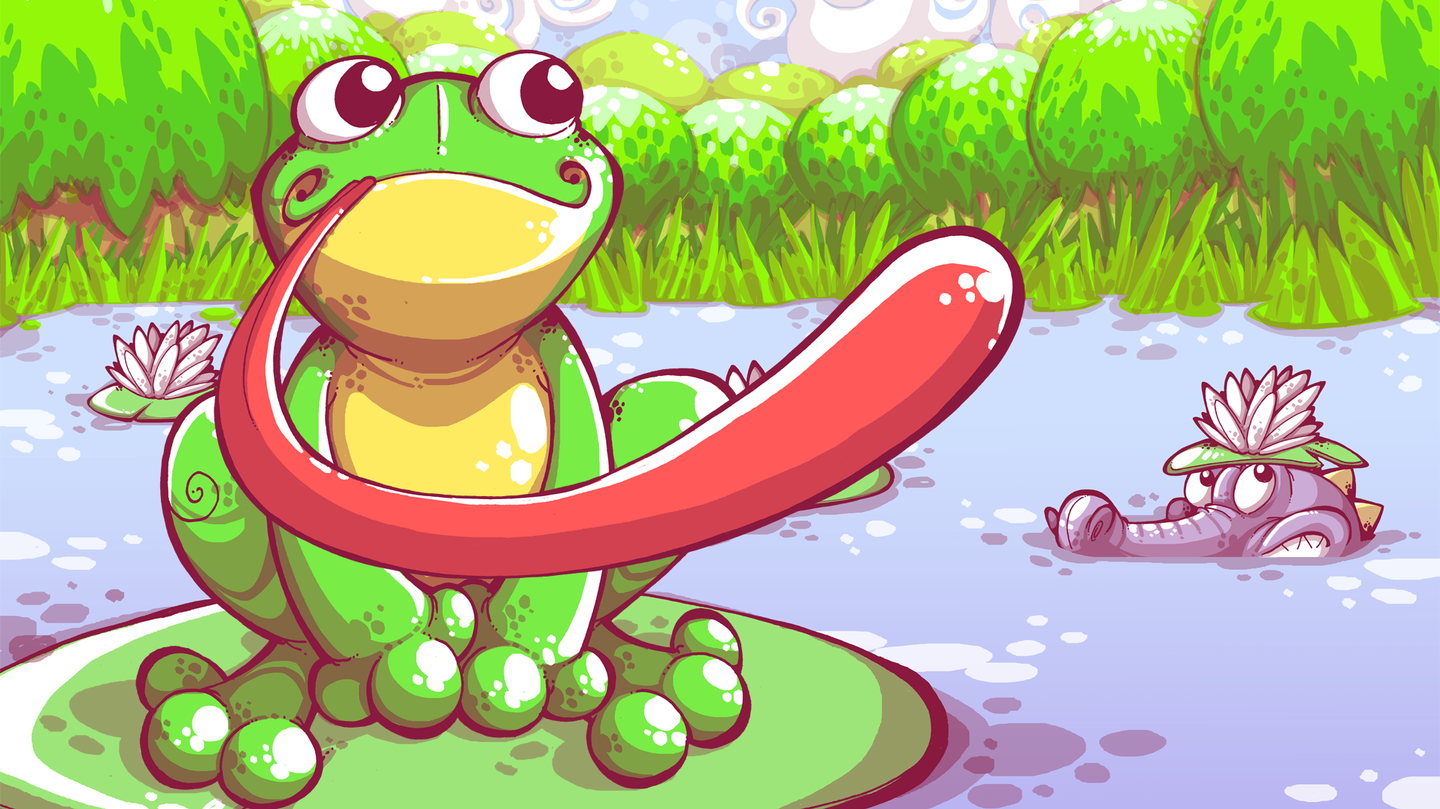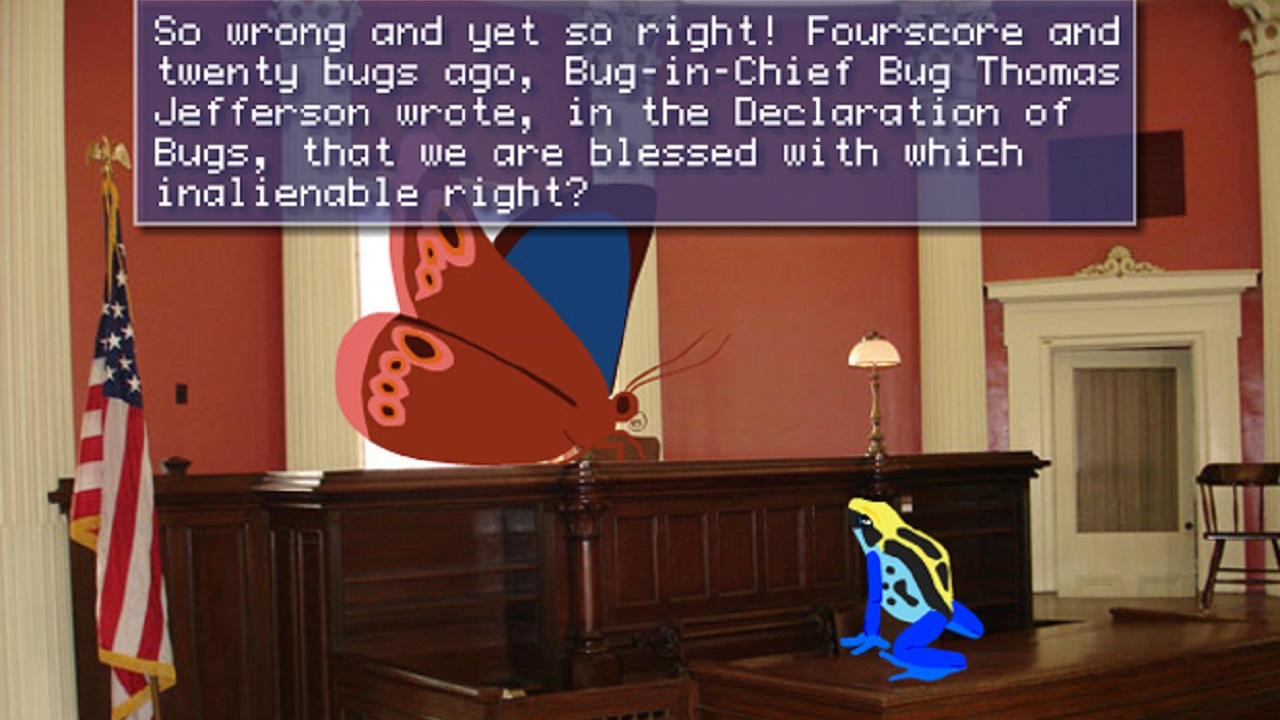The story behind gaming's greatest mystery, Frog Fractions 2
Is this Frog Fractions 2? You bet your ass it is.

There are two ways to sell a game through Kickstarter: The way most people do it, and the way that Jim Crawford does it. The former would tell you about the importance of marketing and communicating with your audience. But Crawford is the antichrist of sensible game publishing. He can sell a game not based on its name, look, or even its genre. People buy them precisely because they don't know what to expect.
Crawford is the mind behind Frog Fractions 2, which was until recently one of the biggest enigmas of modern gaming. After over two years of hunting, a group of several thousand players known as the Game Detectives discovered its sequel nestled inside of an entirely different game last December. It's the final chapter of a tale that includes time travelers, mysterious symbols appearing in random indie games, and a bizarre website where you shave President Obama's face. To some, Frog Fractions and its sequel are tired 'in-jokes' that have gone on too long. But for others, they capture the magic of what can happen when you embrace the absurd. For Jim Crawford, they are series of very fortunate events.
"It's been a weird fucking journey," he tells me.
A frog and his turtle
Frog Fractions was, by Crawford's account, an accident. He's been making games since he was 11 and always dreamed of making them for a living. He just had one problem, however. He loved coming up with new ideas but struggled to complete them. A hard drive brimming with half-finished prototypes and bite-sized flash games, Crawford began working on one that, for some reason, didn't eventually find itself gathering digital dust in an abandoned folder.
For a man who admits to not having the greatest attention span, Frog Fractions is perfect. It starts out as a Missile Command-style spoof on educational games, then grows into an Ace Attorney courtroom battle, then suddenly shifts into an old school text adventure, and continues onward to new genres. Each time you think you have Frog Fractions figured out, it will—quite literally—change the game. Every time Crawford got bored, he could just tack a new genre onto it. Add in the incomprehensible story about a frog and his turtle pal venturing to Bug Mars, getting a work visa, becoming bug president, and then manufacturing bug pornography, and Frog Fractions is the videogame equivalent of playing mad libs on LSD. And people love it.
The day it launched, Crawford says Brandon Sheffield, a senior contributing editor at Gamasutra and game developer tweeted about Frog Fractions and it "blew up from there." Within the first day, Frog Fractions was played by tens of thousands.
Ask anyone why they think Frog Fractions exploded and they'd likely have a different answer. Crawford tells me it was years later that he finally discovered his own. "There's a thing that games used to be that aren't anymore," he says. "Nowadays marketing wants you to know everything about a game before it ships. You can read a guide to know everything about a game. There are people decompiling games and figuring out every nuance of how they work. That stuff is legitimately a good thing, but the downside is that the mystery in games is basically gone. We're drowning in an ocean of content and what's rare is a game that has any sort of mystique to it at all."
Keep up to date with the most important stories and the best deals, as picked by the PC Gamer team.
The mystery in games is basically gone. We're drowning in an ocean of content and what's rare is a game that has any sort of mystique to it at all.
If Crawford was right and a little mystery is what gamers wanted, he was going to give it to them. In March of 2014, Crawford launched a Kickstarter campaign. "I made Frog Fractions in a little over a year, while I had a day job, on no budget, but with a lot of volunteer help," the pitch reads. "In designing it, I made the decision to trust you, the player, to figure out how to unlock the game's secrets without being guided every step of the way. In this Kickstarter, I'm asking you to, in turn, trust me."
What follows is a Kickstarter plan that would make any marketing team squirm. "The premise was I'm going to make this game and you're going to give me money for it and I'm not going to tell you where the game is or what its name is or when it comes out and it won't have my name on it. Basically, give me money and maybe someday you'll have a cool game," Crawford explains. "From a business standpoint that Kickstarter was completely ridiculous. But I had been thinking for a year how do I follow up Frog Fractions? How do I surprise people if they know they're going to be surprised? I came to the conclusion that I had to ship it under a different name and I can't tell people about the release."
"I still can't believe that I got away with it."
On April 9, 2014, Frog Fractions 2 was successfully Kickstarted to the tune of $72,107. Crawford managed to convince people to let him try to capture the insanity of Frog Fractions a second time.
At the gates of madness
Wanting to dial up the mystery surrounding his Kickstarter, Crawford decided to throw in the old remnants of an alternate-reality game (ARG) he'd been working on from a year earlier. But he seriously overestimated how designing both an ARG and Frog Fractions 2 would stretch him. "I didn't think about the consequences of starting an ARG—that people would expect me to finish it."
After several months of doing things solo, Crawford needed help, so he called a friend and offered him a pretty weird job. Justin Bortnick, an English literature Ph.D. candidate, tells me he had no experience running ARGs before but wasn't going to let that stop him. "I'd followed a few ARGs very superficially so I was familiar with the idea, but being tossed into the deep end of running one almost alone was a different story," he says.
If the question remained whether or not Frog Fractions 2 could live up to the original, Crawford's and Bortnick's ARG at least demonstrated the potential was there. Whether it was watching Crawford get kidnapped by time travelers, meeting a man in Berkeley, California, dressed as a bee, or running a file through a Game Boy Advanced emulator only to get Rick Roll'd in 32 bits, the ARG was one ludicrous moment after another.
It even made one ARG player turn coat to help steer the game for several months. Erica Newman had met Crawford to collect a clue that she had won and instead talked her way into choosing where the ARG would go next. "What she told me while we were having lunch was that what she wanted to do was add her own clues to the box and run a side ARG of her own," Crawford says. "I told her to go for it because that's kind of how I work anyway—let's put some weird ideas out there and we'll make it work later." When Bortnick was busy with exams, Crawford handed the ARG over to Newman who handled its final chapters leading to the release of Frog Fractions 2.
What threw everyone for a loop was when it was discovered earlier this year that there wasn't just one ARG behind Frog Fractions 2. The Eye Sigil ARG, which had been active since mysterious symbols first started popping up in various indie games in 2015, had a whole other branch of the Game Detectives looking to solve it. When they finally did, the solution ended up being the username and password for a site containing videos of Crawford and a friend tasting soups. Unbeknownst to everyone, Crawford had been secretly using his connections to work with developers to put "pieces of Frog Fraction 2 into their games."
On the next page, trouble in paradise as Frog Fractions 2 misses its initial deadline and the Game Detectives enter the final stretch.
With over 7 years of experience with in-depth feature reporting, Steven's mission is to chronicle the fascinating ways that games intersect our lives. Whether it's colossal in-game wars in an MMO, or long-haul truckers who turn to games to protect them from the loneliness of the open road, Steven tries to unearth PC gaming's greatest untold stories. His love of PC gaming started extremely early. Without money to spend, he spent an entire day watching the progress bar on a 25mb download of the Heroes of Might and Magic 2 demo that he then played for at least a hundred hours. It was a good demo.



